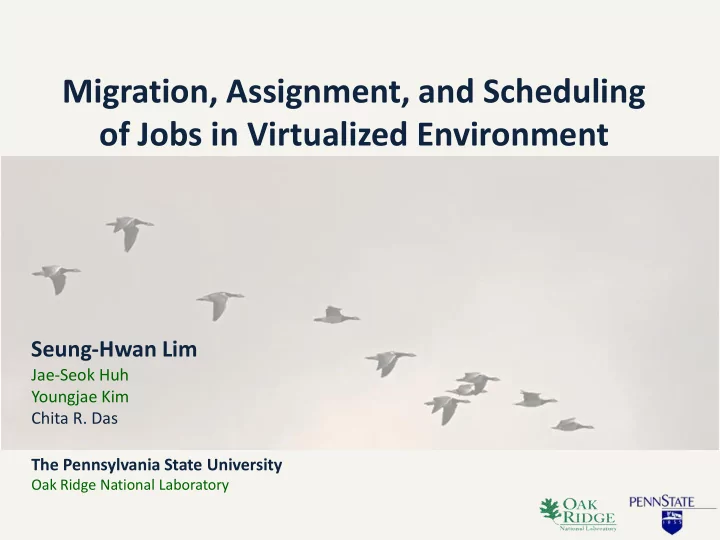

Migration, Assignment, and Scheduling of Jobs in Virtualized Environment Seung-Hwan Lim Jae-Seok Huh Youngjae Kim Chita R. Das The Pennsylvania State University Oak Ridge National Laboratory
Overview Challenges Migration Cost Performance Model Conclusions A Virtualized Environment Basis of Cloud Computing Decouples Operating System Enables migration of OS Instances from Hardware instances (Virtual Machines) HotCloud 2011 2/13
Overview Challenges Migration Cost Performance Model Conclusions Challenges in Virtualized Environment Obstacle Opportunity 1 Availability/Business Continuity Use Multiple Cloud Providers 2 Data Lock-In Standardize APIs, Compatible SW to enable Surge or Hybrid Cloud Computing 3 Data Confidentiality and Auditability Deploy Encryption, VLANS, Firewalls 4 Data Transfer Bottlenecks FedExing Disks; Higher BW Switches 5 Performance Unpredictability 5 Performance Unpredictability Improved VM support; Flash memory; Gang Schedule VMs Improved VM support; Flash memory; Gang Schedule VMs 6 Scalable Storage Invent Scalable Store 7 Bugs in Large Distributed Systems Invent Debugger that relies on Distributed VMs 8 Scaling Quickly Invent Auto-Scaler that relies on ML; Snapshots for Conservation 9 Reputation Fate Sharing Offer reputation-guarding services like those for email 10 Software Licensing Pay-for-use licenses From Armbrust et al., A view of cloud computing. Commun. ACM, April 2010 HotCloud 2011 3/13
Overview Challenges Migration Cost Performance Model Conclusions Unpredictable Performance May Cause Performance variance among jobs may create Propagation Effects cascaded effects in all the related jobs completion time J1.1 J1.1 J2 J1.2 J2 J1.2 J1.3 J1.3 Desired With performance variance Repels performance critical applications. VM assignment/scheduling schemes consider performance HotCloud 2011 4/13
Overview Challenges Migration Cost Performance Model Conclusions Job Scheduling An optimization problem to find assignment of jobs to the given set of machines so as to minimize the total completion time of jobs Jobs J Total completion time m1 m2 Machines M m3 HotCloud 2011 5/13
Overview Challenges Migration Cost Performance Model Conclusions During (Re-)Assigning VMs Migration policy determines the amount of time to A set of VMs migrates reassign VMs and hence impacts performance PM1 V1 V4 after ? PM2 after Physical V2 V5 ? Machines PM with ? PM3 V3 completion time PM1 V1 PM2 V2 V4 Physical Machines PM PM3 V3 V5 HotCloud 2011 6/13
Overview Challenges Migration Cost Performance Model Conclusions VM Migration Sender Machine Sender VM Domain-0 (CPU0, 1) Migration in Sender Receiver VM VM2 (CPU0) VM1* (CPU1) migration time = down time (a) A non-live migration Receiver Machine Sender VM Domain-0 (CPU0, 1) down time ~ 0 Migration in Receiver Receiver VM VM3 (CPU0) migration time (b) A live migration VM1* migrates Types of VM migrations HotCloud 2011 7/13
Overview Challenges Migration Cost Performance Model Conclusions Cost of VM Migration When a set of VM migrates, how do we minimize T while bounding β ? Total Migration Time T Performance Impact β 35 25 VM1 (migrated VM) multiple 256MB VMs (1G Ethernet) # of compressed files /sec 30 single VM (1G Ethernet) VM2 (non-migrated in Sender) Total Migration Time (sec) 20 multiple 256MB VMs (Infiniband) VM3 (non-migrated in receiver) 25 single VM (infiniband) 15 20 15 10 10 5 5 0 0 Pre-Migration Migration Post-Migration 0 256 512 768 1024 1280 1536 1792 2048 2304 2560 2816 Workload : Compressing 256KB files. Total size of migrated memory (MB) Migration policy decides total migration time Migration impacts performance Slightly faster than ten sequential migrations (30.9sec < 10x3.1 sec, 22.8 sec< 10x2.6sec) , but with greater performance impact HotCloud 2011 8/13
Overview Challenges Migration Cost Performance Model Conclusions Minimizing time T while bounding performance variation β Desired is an accurate estimator of T and β when multiple jobs contend for multiple resources * *A generic model for n job and m resources has been developed. HotCloud 2011 9/13
Overview Challenges Migration Cost Performance Model Conclusions Performance of Shared Systems with Multiple Resources 250 Total Completion Time ( sec ) Total completion time may not be Measurement D-factor Linear linear to individual completion times 200 150 Waste System Resources 100 CPU I/O 50 0 p CPU w/CPU CPU w/IO IO w/ CPU IO w/ IO Actual j completion Both CPU job and I/O job take 100 sec time T without presence of other workloads Bin packing or scheduling algorithms use linear relation HotCloud 2011 10/13
Overview Challenges Migration Cost Performance Model Conclusions Estimating Completion Time T Assume two 2-resource-busy jobs with their loading vectors, access probability of each resource, p i = ( p i , 1-p i )*. Then, expanded completion time T of each job is given by ( 1 ( 1 )( 1 )) T p p p p Without 1 1 1 2 1 2 1 2 other jobs T ( 1 p p ( 1 p )( 1 p )) 2 2 1 2 1 2 1 2 Linear estimation From original completion time CPU Disk I/O CPU Disk I/O OR Job 1 Job 1 Job 2 Job 2 * Without resource monitoring, loading vectors can be constructed (Algorithm 1) HotCloud 2011 11/13
Overview Challenges Migration Cost Performance Model Conclusions Estimating Performance Variation β Consider slow-down of jobs in the system as the performance variation Given τ j, define performance impact β by T j We can calculate this j j Execution time of job j with other jobs Slow downs of all jobs Slow down of job j Execution time of job j without other jobs HotCloud 2011 12/13
Overview Challenges Migration Cost Performance Model Conclusions Robust and Predictable Performance Migration-Aware Schedulers Assignment Cost Analysis (Performance bound β and completion time of assignment T ) Migration Cost Analysis (Profile migration as a job) Performance Model (Shared systems with multiple resources) HotCloud 2011 13/13
Migration, Assignment, and Scheduling of Jobs in Virtualized Environment Seung-Hwan Lim (seulim@cse.psu.edu)
Recommend
More recommend